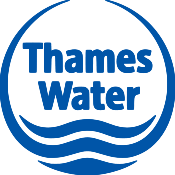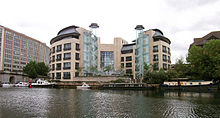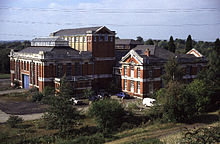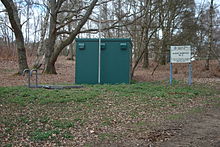Thames Water
 |
|
| Type | Private |
|---|---|
| Industry | Water industry |
| Founded | 1989 |
| Headquarters | Reading, Berkshire, United Kingdom |
| Key people | Sir Peter Mason, KBE (Chairman) Martin Baggs (CEO) |
| Services | Water supply and sewage treatment services |
| Employees | 4,800 |
| Parent | Kemble Water Ltd |
| Website | www.thameswater.co.uk |

Thames Water Utilities Ltd, known as Thames Water, is the private utility company responsible for the public water supply and waste water treatment in large parts of Greater London, the Thames Valley, Surrey, Gloucestershire, Wiltshire, Kent, and some other areas of in the United Kingdom. Thames Water is the UK's largest water and wastewater services company, and supplies 2.5 gigalitres of drinking water a day, and treats 4 gigalitres of wastewater a day. Thames Water's customers represent 27% of the UK population. [1]
Thames Water is responsible for a range of water management infrastructure projects including: the Thames Water Ring Main around London; Europe's largest wastewater treatment works[2] and the UK's first large-scale desalination plant.[3] Infrastructure proposals by the company include the proposed £4.2 billion London Tideway Tunnels,[4] and the proposed reservoir at Abingdon, Oxfordshire, which would be the largest enclosed or bunded reservoir in the UK.[5]
Thames Water is regulated under the Water Industry Act 1991 and is owned by Kemble Water Limited, a consortium formed in 2007 by Australian-based Macquarie Group's European Infrastructure Funds specifically for the purpose of purchasing Thames Water.
Contents |
History[edit]
Thames Water can trace its history back to numerous earlier companies and individuals stretching back to the early 17th century:
-
1600s, 1610s Edmund Colthurst, Hugh Myddelton and later Sir John Backhouse were the driving forces behind the New River Company and the New River, which routed water from Hertfordshire to New River Head in Islington, and provided an additional source of drinking water to London. 1850s Joseph Bazalgette's remediation of The Great Stink provided the company with much of London's present Victorian sewerage infrastructure and several listed buildings within its portfolio of sites. Also in the 1850s, Dr John Snow's identification of the 1854 Broad Street cholera outbreak provided a stimulus to the better treatment of sewage. 1973 The Thames Water Authority was founded, under the terms of the Water Act 1973, and took over the following water supply utilities and catchment area management bodies:[6] - Cotswold Water Board
- Croydon Corporation
- Epsom and Ewell Corporation
- The Lee Conservancy
- Metropolitan Water Board, responsible for water supply in London.
- Mid Southern Water Company
- Middle Thames Water Board
- Oxfordshire and District Water Board
- South West Suburban Water Company
- Swindon Corporation
- Thames Conservancy, responsible for managing the non-tidal River Thames (powers taken until 1989).
- Thames Valley Water Board
- Watford Corporation
- West Surrey Water Board
1989 Thames Water was privatised as Thames Water Utilities Limited, entailing the transfer of navigation, regulatory, river and channels management to the National Rivers Authority that later became part of the Environment Agency.[7] The company became listed on the London Stock Exchange and was a constituent of the FTSE 100 Index. 2001 Thames Water plc was acquired by the German utility company RWE.[8] As well as its British operations, it became an international water treatment consultancy and acquired some overseas operations. 2006 On 17 October 2006, following several years of criticism about failed leakage targets in the UK, RWE announced that it would sell Thames Water to Kemble Water Limited for £4.8 billion (since Thames Water had net debts of £3.2 billion, this implied an enterprise value of £8.0 billion). In December 2006, the sale of the Thames Water's British operation went ahead, with RWE keeping the overseas operations.[9] Kemble is a consortium led by an investment fund run by the Australian Macquarie Bank. Australian investment funds already have interests in South East Water and Mid Kent Water. 2007 Under the new ownership, the company re-focused its efforts on improving its operational performance and announced the largest-ever capital investment (£1 billion) of any UK water company.[10] 2012 Some of the company's stock was acquired by the China Investment Corporation,[11] the Abu Dhabi Investment Authority [12] and the BT Pension Scheme [13]
Thames Water was a Tier Three Sponsor for the London 2012 Olympic Games [14]
Performance[edit]
Every day, Thames Water supplies 2.5 gigalitres (2.5×109 litres) of potable tap water from 102 water treatment works via 288 clean water pumping stations through 32,000 km (20,000 mi) of managed water mains to 9 million customers (3.6 million properties) across London and the Thames Valley.[15] It maintains 30 raw water reservoirs and 235 underground service reservoirs. [1]
Likewise, it daily removes and treats 4 gigalitres (4.0×109 litres) of wastewater from 14 million customers (5.1 million properties) using 2530 sewage pumping stations through 109,000 km (68,000 mi) of managed sewerage mains to 350 sewage treatment works across an area of South England.[15] On 1 October 2011, it adopted 40,000 kilometres (25,000 mi) - an additional 60% - of private sewers and lateral drains to add to its existing stock of 69,000 kilometres (43,000 mi) giving the current total of 109,000 kilometres (68,000 mi) managed sewerage mains. Before 1 October 2016, it is obliged to adopt 5,000+ private sewage pumping stations to add to its existing stock of 2530 managed sewage pumping stations [1][16]
As of 2013[update], it recovered approximately 12.5% (18 MW, or 156 GWh per annum) of its total energy requirements from renewable electricity generated from biogas collected from the sewage. Further biogas capacity, the burning of 'fatbergs' removed from London's sewers and substantial solar farms have enabled the company to announce a 2015/2016 target of generating 20% (36MW, or 318 GWh per annum) of its total energy requirements from renewable sources. [1][17][18]
Leakage[edit]
- Up to 2006 (RWE's ownership)
Thames Water was repeatedly criticised for the amount of water that leaked from its pipes by the industry regulator Ofwat and was fined for this.
In May 2006 the leakage was nearly 900 megalitres per day (Ml/day) and in June that year Thames Water missed its target for leakage reduction for the third year in a row.[19] Also in June 2006 the firm announced a 31% rise in pre-tax profits to £346.5m. The Consumer Council for Water, a customers' group, accused Thames Water for continuing to miss their targets for the past five years. In July 2006, instead of a fine which would have gone "to the exchequer", the company was required to spend an extra £150 million on repairs.[20]
- Since 2007 (Kemble's ownership)
Thames Water has hit its Ofwat-agreed annual leakage-reduction target for the past seven years running (2006 to 2013). [1]
In 2006-07, the company stated that it had reduced its daily loss through leaks by 120 Ml/day to an average of 695 Ml/day.[21] For 2009-10 Ofwat reported leakage was 668.9 Ml/day.[22] In its price control determination for the period 2010 to 2015, Ofwat did not allow the funds needed to finance a significant further reduction in leakage and used the assumption that leakage would be 674 Ml/day in 2010-11 and 673 Ml/day from 2011-12.[23] The target for 2011-12 was surpassed by more than 30 Ml/day. In 2012-13, actual leakage was 646 Ml/day. [1]
The company has achieved these reductions by replacing 2,200 km (1,400 mi) of worn-out Victorian pipes, mainly under London, reducing leakage from its 32,000 km (20,000 mi) network of water pipes to its lowest-ever level, down more than a third since its peak in 2004.[24] As of 2012 and with an older network profile, Thames Water leaks 26% of supply, slightly less than Severn Trent at 27%.[25]
The recent successes in meeting leakage targets have mitigated the earlier failures to meet targets. As a result, Thames Water now leaks slightly less water than at privatisation in 1989.
Pollution[edit]
- The Thames Tideway
Joseph Bazalgette's remediation of the 1850s Great Stink renewed much of London's sewerage mains infrastructure. However, the new design was not intended to cope with the doubling of London's population over the following 150 years. The concreting of huge amounts of London's green spaces causes substantial rainwater run-off into the sewerage system which had been expected to soak into the ground. As a result, even small amounts of rainfall in certain circumstances can cause London's outdated Victorian sewerage system to fail over, and release untreated sewage mixed with rainwater into the Thames Tideway.
Each year, on average, there are 50-60 such incidents and a total of 39,000,000 m3 (3.9×1010 l), or 39 million tonnes, of untreated sewage mixed with rainwater is released directly into the Thames Tideway. [26]
Between 2001 and 2004, 240,000,000 m3 (2.4×1011 l), or 240 million tonnes, of untreated sewage mixed with rainwater were released into the Thames Tideway.[27]
Between 24 and 29 June 2005, 1,000,000 m3 (1.0×109 l), or 1 million tonnes, of untreated sewage mixed with rainwater was released into the Thames Tideway.[28]
On 5–8 June 2011, more than 230,000 m3 (230,000,000 l), or 230,000 tonnes, of sewage were released from Mogden Sewage Treatment works into the Thames Tideway killing 26,000 fish.[29]
The first two stages of the London Tideway Improvements are upgrades to 5 sewage treatment works and construction of the Lee Tunnel, due for completion in 2014. Together, these should result in an annual reduction of discharges by 40%, or by 16 million tonnes [30] to about 23 million tonnes per year. The third stage is the Thames Tideway Tunnel, which has been proposed by the Thames Tideway Strategic Study, including Thames Water, as an effective solution to deal with most of the remaining problem. Alternative proposals by other parties exist. The necessity for action has added urgency because of imminent water quality fines of up to £1bn on the UK Government by the European Commission. [31][32]
- Other incidents
In 2004, Thames Water supplied rust-coloured water to residents of Spencers Wood and Shinfield, nr Reading, Berkshire and was fined £24,000.[33]
In September 2007, 5 km (3.1 mi) of the River Wandle was polluted. In January 2009, Thames Water pleaded guilty and was "fined £125,000 and ordered to pay £21,335 in clean-up and investigation costs".[34] In February 2010, on appeal, the fine was found to be "manifestly excessive" and was reduced to £50,000.[35]
Between 14 and 16 August 2011, Thames Water polluted the Faringdon Stream, in Faringdon, Oxfordshire. The company was fined £10,000 and ordered to pay costs of £4,488 [36]
On 29 October 2011, Thames Water released thousands of tonnes of raw sewage into the River Crane killing thousands of fish, when a six-tonne valve jammed shut during routine maintenance. Despite tankering, the volume of sewage from Heathrow overwhelmed the precautions. Thames Anglers Conservancy member, Robin Vernon, of Devon Avenue said: “It will take a decade to repair all the damage done by the sewage spill. Everything in there is just dead now.”.[37] In 2013, fungus and slime in the River Crane was attributed to run-off of de-icer from Heathrow getting into the river [38]
On 9 December 2011, Thames Water were fined £60,000 after pumping sewage sludge into the Foudry Brook killing up to 20,000 fish.[39][dead link]
Local planning[edit]
In 2011, the company found itself involved in a controversial redevelopment plan for the Bath Road Reservoir in its home town of Reading. An appeal against Reading Borough Council's rejection of the plan was dismissed by the planning inspector in January 2011.[40] Full planning permission has since been granted on 10 December 2012.[41]
References[edit]
- ^ a b c d e f "Annual Performance Report 2012-2013" (PDF). Thames Water. June 2013. Retrieved 16 June 2013.
- ^ "Bye-bye big stink" (PDF). Beckton in Focus, The Newham Mag, London Borough of Newham. April 2010. Retrieved 9 March 2013.
- ^ "Thames Water Desalination Plant, Beckton". Water-technology.net. Retrieved 2 September 2012.
- ^ "Thames Tideway Tunnel". London Councils website. Retrieved 9 March 2013.
- ^ "Need for reservoir 'not proven'". BBC News. 5 January 2007. Retrieved 12 February 2011.
- ^ The Thames Water Authority Constitution Order 1973
- ^ Larry Elliott and Jill Treanor (22 November 2000). "A whole world sold on sell-offs". The Guardian. Retrieved 9 March 2013.
- ^ "Germany's RWE in frame for Thames Water owner Takeover bid for power giant sparks surge in share price". The Herald, Scotland. 19 February 2002. Retrieved 9 March 2013.
- ^ Edmund Conway and Ben Harrington (17 October 2006). "Macquarie buys Thames Water in £8bn deal". The Telegraph. Retrieved 9 March 2013.
- ^ "Thames Water in £1bn leaks plan". BBC News. 29 June 2007. Retrieved 9 March 2013.
- ^ "China wealth fund buys nearly 9% of Thames Water". BBC News. 20 January 2012. Retrieved 9 March 2013.
- ^ "Macquarie sells 9.9% stake in Thames Water to Abu Dhabi Investment Authority". Waterbriefing.org. 13 December 2011. Retrieved 23 March 2013.
- ^ "BT Pension Scheme seals deal for 13pc stake in Thames Water". The Telegraph. 30 May 2012. Retrieved 23 March 2013.
- ^ Duncan Mackay (31 May 2011). "London 2012 sign up Thames Water as sponsor". insidethegames.biz. Retrieved 9 March 2013.
- ^ a b "GIS Foundation at Thames Water". Barnsnape Consulting. 2008. Retrieved 2 September 2012.
- ^ "Thames Water Utilities Limited: Annual Report & Financial Statements for the Period ended 31 March 2012". Thames Water. 26 June 2012. Retrieved 2 June 2013.
- ^ "Thames Water and 2OC in £200m deal to turn ‘fatbergs’ into energy". waterbriefing.org. 8 April 2013. Retrieved 2 June 2013.
- ^ "Thames Water to generate 20 per cent of energy needs with sewage scheme". utilityweek.co.uk. 5 March 2013. Retrieved 2 June 2013.
- ^ "Thames Water misses leak target". BBC News. 22 June 2006. Retrieved 9 March 2013.
- ^ "Thames Water escapes leakage fine". BBC News. 4 July 2006. Retrieved 9 March 2013.
- ^ "Thames Water hails leak progress". BBC News. 26 November 2007. Retrieved 12 February 2011.
- ^ "Service and delivery – performance of the water companies in England and Wales 2009-10 - Supporting information" (PDF). Ofwat. 27 October 2010. p. 46. Retrieved 12 February 2011.
- ^ "Future water and sewerage charges 2010-15: Final determinations" (PDF). Ofwat. 26 November 2010. pp. 50–52. Retrieved 12 February 2011.
- ^ "Thames Water leakage - explanatory graphs" (PDF). Ofwat. Retrieved 9 March 2013.
- ^ Fred Pearce (8 May 2012). "The water industry is burying a leaking pipes scandal". The Guardian. Retrieved 9 March 2013.
- ^ "Thames Tunnel Consultation". Thames Tunnel partnership. Retrieved 9 March 2013.
- ^ Paul Brown (20 December 2004). "Sewage dumped in Thames every month". The Guardian. Retrieved 2012-09-02.
- ^ "Tunnel 'needed' for Thames sewage". BBC News. 20 July 2005. Retrieved 2 September 2012.
- ^ "Thousands of River Thames fish killed by storm sewage". BBC News. 8 June 2011. Retrieved 2 September 2012.
- ^ Luke Cross (13 November 2012). "Open Doors: Lee Tunnel lifts lid on 'exciting' world of construction". Construction News. Retrieved 9 March 2013.
- ^ "UK faces fine on EU water breach". BBC News. 18 October 2012. Retrieved 8 June 2013.
- ^ Fiona Harvey (26 January 2012). "Thames super-sewer a 'necessity' to prevent EU fines". The Guardian. Retrieved 8 June 2013.
- ^ "Thames Water fined for supplying dirty water". Swindon Advertiser. 24 November 2006.
- ^ Britain’s largest water company prosecuted for 5km river pollution, Environment Agency, February 2009; retrieved on 5 February 2009.
- ^ "Thames Water fine for toxic spill in River Wandle cut". BBC News. 15 February 2010. Retrieved 9 March 2013.
- ^ "Thames Water ordered to pay £14K+ for stream pollution". waterbriefing.org. 25 February 2013. Retrieved 9 March 2013.
- ^ Rachel Bishop (1 November 2011). "River Crane 'destroyed' by sewage spill". Richmond and Twickenham Times. Retrieved 2 September 2012.
- ^ "Heathrow blamed for slime pollution in river". Hounslow Chronicle. 21 March 2013. Retrieved 27 March 2013.
- ^ "Thames Water forced to pay out £60,000 over sewage spill". Reading Post. 9 December 2011. Retrieved 2 September 2012.
- ^ "Bath Road reservoir homes appeal rejected after inquiry". BBC News. 15 January 2011. Retrieved 9 May 2011.
- ^ "Consultation on Construction of Homes at Bath Road Reservoir Site". Reading Borough Council. 7 February 2013. Retrieved 23 March 2013.
External links[edit]
|
|||||||||||
|
||||||||
|
|||||||||||||||||||||||
- Companies based in Reading, Berkshire
- London water infrastructure
- Water companies of England
- Utilities of the United Kingdom
- Former nationalised industries of the United Kingdom
- Organizations established in 1973
- Organizations disestablished in 1989
- Companies established in 1989
- Thames Water
- Companies formerly listed on the London Stock Exchange
- Geography of the River Thames
- Former water company predecessors of Thames Water
- 1973 establishments in England
- Companies supplying water and sanitation to London




